Atomic Bomb-making Wastes Threaten Missouri Neighborhood
Air Date: Week of May 8, 2015
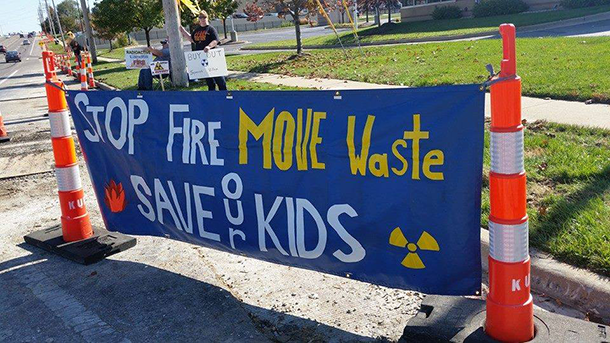
Protest sign in the area around the West Lake landfill in St. Louis (Photo: Center for Health, Environment and Justice)
The toxic waste disaster at Love Canal, New York, sparked the landmark Superfund legislation to clean up poisonous waste sites. Lois Gibbs, a leader in the effort to organize Love Canal residents is now working with families near a landfill site in St. Louis where radioactive leftovers from the atom bomb program in WW2 are buried. The site is associated with elevated rates of rare cancers. A fire in a nearby landfill fire threatens to spread to the radwaste site, and the community is demanding evacuation. Host Steve Curwood discusses the situation Lois Gibbs.
Transcript
CURWOOD: From the Jennifer and Ted Stanley Studios in Boston and PRI, this is Living on Earth. I’m Steve Curwood. In suburban St Louis, people are waking up to a toxic waste catastrophe, and the trouble is treble. First, murky records indicate that the West Lake Landfill in the small City of Bridgeton, Missouri is loaded with high-level radioactive waste, possibly including decay products from weapons grade uranium. A Washington University report says the rad-waste has migrated into groundwater linked to the floodplain of the Missouri River. Second, a neighboring waste dump in Bridgeton is on fire underground, about 1000 feet from the West Lake site’s underground radioactive plume. And third, in this area the rates of rare childhood cancers are high. Lois Gibbs, the environmental activist who famously organized parents to protect the health of families at Love Canal, is working with St Louis families who live near the waste sites, and she joins us now to discuss the situation. Welcome back to Living on Earth.
GIBBS: Thank you. I'm happy to be here.
CURWOOD: So first of all how did radioactive waste wind up at the Westlake landfill there in St. Louis?
GIBBS: It ended up there because it's part of the Manhattan Project. St. Louis was big in doing the Manhattan Project many, many years ago, and so the waste was deposited all around the St. Louis area and then they started to clean it up; when they cleaned it up they put it in the Westlake landfill not realizing that it was as much of a danger as it has now become.
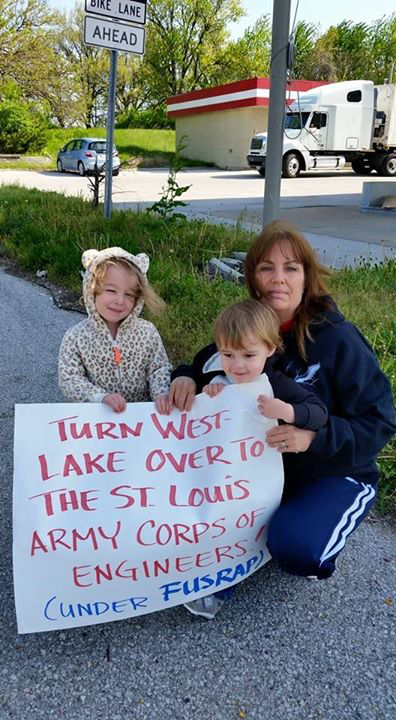
A family living near the West Lake Landfill (Photo: Center for Health, Environment and Justice)
CURWOOD: How did the government go through the process of approving the dumping of this waste in the Westlake neighborhood there?
GIBBS: Well, that's a real good question. Nobody seems to be able answer to that. They were supposed to clean up the radioactive waste from different parts throughout the region there - Bridgeton, Westlake - and what they ended up doing was putting it in this dumpsite. They believed that it was low-level waste so they didn't have to worry about it but as it turns out it was very high-level waste. And it's an unlined landfill, which used to be a quarry so when you think about quarries, just think about how deep they are. It was disposed of in there and then covered up and essentially sold to Republic Services afterwards.
CURWOOD: So we're talking about uranium? What kind of stuff is there?
GIBBS: Uranium is definitely there, it's very high-level radioactive material, the stuff that people keep talking about wanting to put in Yucca Mountain or another secure location far, far away from both groundwater and human health. And it's very, very, very, very dangerous.
CURWOOD: Which government body did this originally and who's responsible for it now in your view?
GIBBS: Right now it's the responsibility of the federal government. The Environmental Protection Agency actually took the two landfills and declared them one Superfund site. They're trying to figure out what to do with this waste. The local community is asking him to dig it up and take it out into a secure place. EPA is saying no, maybe we can just leave it on site, but it's so hazardous.
The other thing that's really interesting about this case that makes it I think especially dangerous is next to the Westlake landfill where all the radioactive material is very high-level radioactive material is a garbage dump. This is the Bridgeton site. And this too was once a quarry, so it's quite deep, and this quarry has caught on fire and has been burning for four years. The scary part is that the fire is moving towards the neck of the radioactive material in Westlake. I mean, literally, these two dumpsites are only 1,000 feet apart. When fire reaches the radioactive site, no one knows what is going to happen. It's just so frightening and around the community is people - moms and dads and families and dogs and cats and schools and they're all panicked.

A child who lives near the West Lake landfill. Researches found an increased rate of brain cancer in the area around the landfill, and residents say their children have experienced hair-loss and respiratory problems, which they think are caused by the nuclear waste and/or the landfill fire. (Photo: Center for Health, Environment and Justice)
CURWOOD: So the fire sounds like it's a ticking time bomb there. What have you been told could happen if the fire does reach the radioactive waste?
GIBBS: If the fire reaches the radioactive dump there will be ‘an event.’ Now the emergency services guys came out to the community and told them if there is an event what you need to do is shelter in place. All the families need to shelter in place and you need to shelter in place for probably a week because what we need to do is go around with a testing equipment like a Geiger counter and we have to test every car, every swing set, every backyard, every front yard, and so you cannot exit your home until after we done that testing. A funny story is when one gentleman stood up when an emergency guy was telling the story and said, "What am I supposed to do with my dog, train him with kitty litter? I have to take my dog out." You're gonna have to shelter in place for two weeks until we test every single piece of property to know whether or not it's radioactive to a level that's unhealthy? That's insane.
CURWOOD: So what's being done to prevent that from happening? What's being done to stop that fire from reaching the radioactive material.
GIBBS: So they're talking about putting a barrier between the two dumps, sort of a barrier wall if you will. But the problem with that is that's two years down the line and before they even get this study out and the proposal and then of course it has to go to public comment. The fire could reach there much faster, it just depends on how much oxygen gets into the dirt and some people are saying that if they dig that ditch to put that wall there it could introduce oxygen to the site and the oxygen will cause it to move quicker over to the radioactive site and then we don't know what's going to happen, ‘an event’ will happen.
CURWOOD: Now, how has the contamination there affected people's health? What’s the public health situation around this radioactive material?
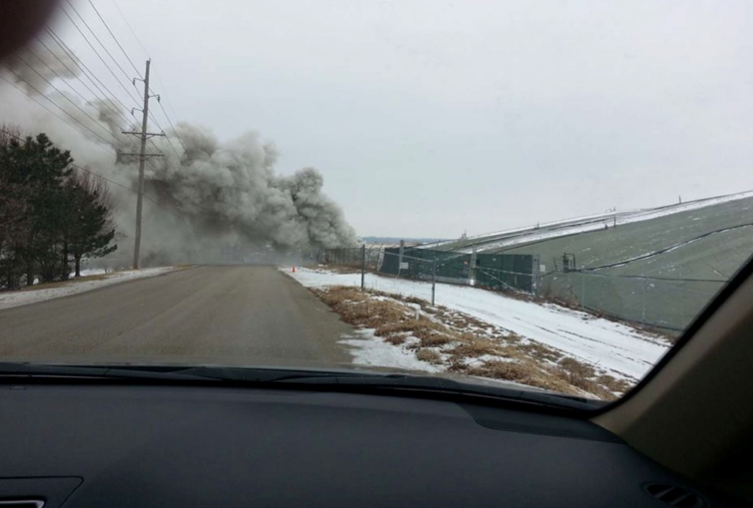
Smoke from the Bridgeton landfill fire. (Photo: Center for Health, Environment and Justice)
GIBBS: Well, there's been a number of studies and what they're finding in the studies is that there is a 300 percent increase in the last few years of brain cancer in young children and this is really frightening. We have a number of the leaders of the local community whose children have died from brain cancer, immune system problems, leukemia, I mean, it just goes on and on and on. And these are not wealthy people. These are community people who are a working class community, they don't have a lot of money, they're trapped in their houses and they're just watching their children get sicker and sicker.
CURWOOD: How sure are they that the cancers are being caused by the radioactivity, do you think?
GIBBS: Well like most studies they're saying that there is a cluster there. They believe it is related to the radioactivity and or the smoke but nobody ever puts one and one together. We've been through this before with Woburn, Massachusetts, Love Canal and the other sites but you know there is a cluster and the only thing these folks have in common is the radioactive material and the smoke from the burning landfill.
CURWOOD: The smell from the burning landfill so I guess, well, doesn't smell very nice. You've been there. What does it smell like?
GIBBS: It smells like rotten eggs. There was a journalist who was there a couple weeks ago when the cover of the burning landfill - they have like a canvas cover on top of it - when it ripped open because it was pillowing up and he just took one whiff and started vomiting on the side of the road. This is what people have to live with every single day. The attorney general has filed notices of violation almost every quarter. It's above standards, air standards, and people are living with this every single day and they literally cannot go outside.
One of the moms tells an interesting story it’s that when she puts her children outside she puts a timer on her oven for 15 minutes and when the timer pings she goes out to smell the air to make sure that is not full of smoke and chemicals because you can actually smell the stuff. You can't smell the radon, you can't smell the radioactive material, of course, but you can certainly smell the smoke and the toxics that are burning next door, and so she'll go out, smell the air and if it doesn't smell too bad then she'll go back in the house and set the timer for 15 minutes again and keep on checking. This is how people have to live there because it's radioactive material and it's smoke and it's toxic and is going literally into their homes into their yards and there's no escape.
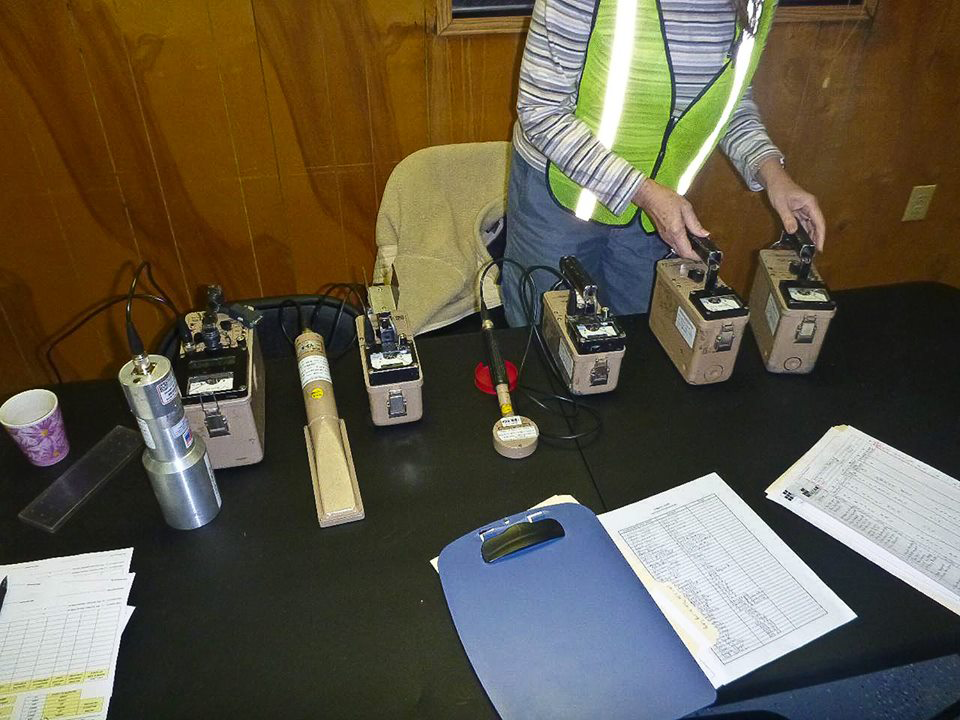
Radiation detectors used at the West Lake landfill. (Photo: US EPA Region 7)
CURWOOD: It sounds like a nightmare.
GIBBS: It is a nightmare and you know the federal government is responsible because it's a Superfund site. They've mismanaged the site for years. There's nobody paying attention to this, nobody dealing with this, and the community is so frustrated that they been picketing EPA, they been writing letters, they've gotten their Senator MacCastle and their Senator Blunt to do a letter to EPA and we still haven't gotten any action. There's nobody there who knows about this site, nobody there who’s taking care of the site and Gina McCarthy the administrator just refuses to meet with us and what the community is looking for is the evacuation of their families. They really need to get out and Gina McCarthy does have the authority under Superfund to evacuate the community.
CURWOOD: Now when you confronted the government about the situation at Love Canal one of the things that happened down the road was the creation of the whole Superfund process, the designation of sites and such. How do you feel that Superfund doesn't seem to be working to help these people?
GIBBS: No, it doesn't. I'm not sure if Superfund...Superfund has a provision in it that says if you can't stop exposure in a timely manner then you can move the people. So they have authorization to do that and we made sure that was in there when we put Superfund together years ago. I don't understand why there is resistance to doing this; I've been involved in 16 relocations across the country - Pensacola Florida and Times Beach and so forth - and I don't understand it because the state is supporting relocation, the state is supporting doing something by EPA. It's EPA who's holding strong and it just doesn't make any sense. But I don't think it’s Superfund, I think it's the administration of Superfund that's creating the problem.
CURWOOD: Lois, what about the company that owns this, Republic Services Incorporated? I understand they bought it from Browning-Ferris Industries but it's theirs now. How are they responding and how are you reaching out to them.
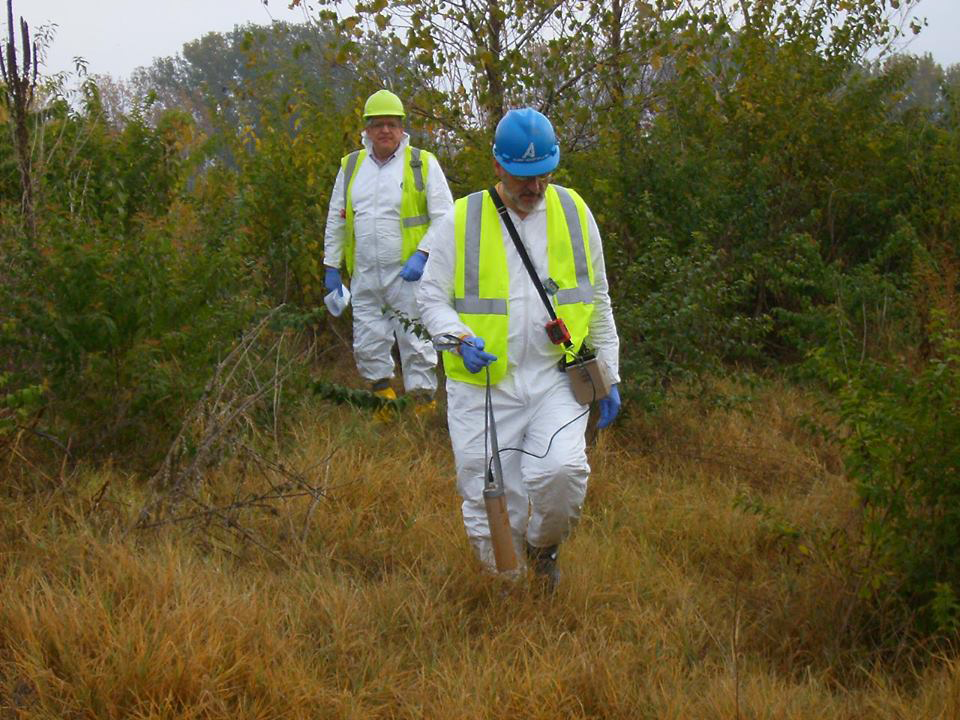
Contractors scanned for radiation at the West Lake site. (Photo: U.S. EPA Region 7)
GIBBS: Well, one of the things we're doing with them is that we're going after Bill Gates. Bill Gates is a significant shareholder of Republic Services. Republic Services is saying we're not responsible. We didn't know when we bought it. But Bill Gates really cares about health and children's health. He just divested from McDonald's, for example, to keep children healthy, so we are asking him to use his position as a shareholder to really ask them to evacuate these people.
CURWOOD: Republic Services says well, they didn't know, they didn't have anything to do with this. but the Superfund law says, hey, if you own it you have to own all the problems of the past.
GIBBS: That's right. They should've done due diligence. My understanding is they just bought BFI, and as a result of that they took the good and the bad, but you're because they didn't know doesn't make them innocent.
CURWOOD: That how the Superfund law works, right?
GIBBS: That's how the Superfund law works, that Superfund says you are joint and severally responsible, meaning that the Republic services is responsible for Westlake and Bridgeton they are responsible not only for the remedy of cleanup but they're also responsible to care for the human health and the environment around that site and do it right, using the St. Louis Corps of Engineers to take that radioactive waste out of that site and put it in a secure location somewhere.
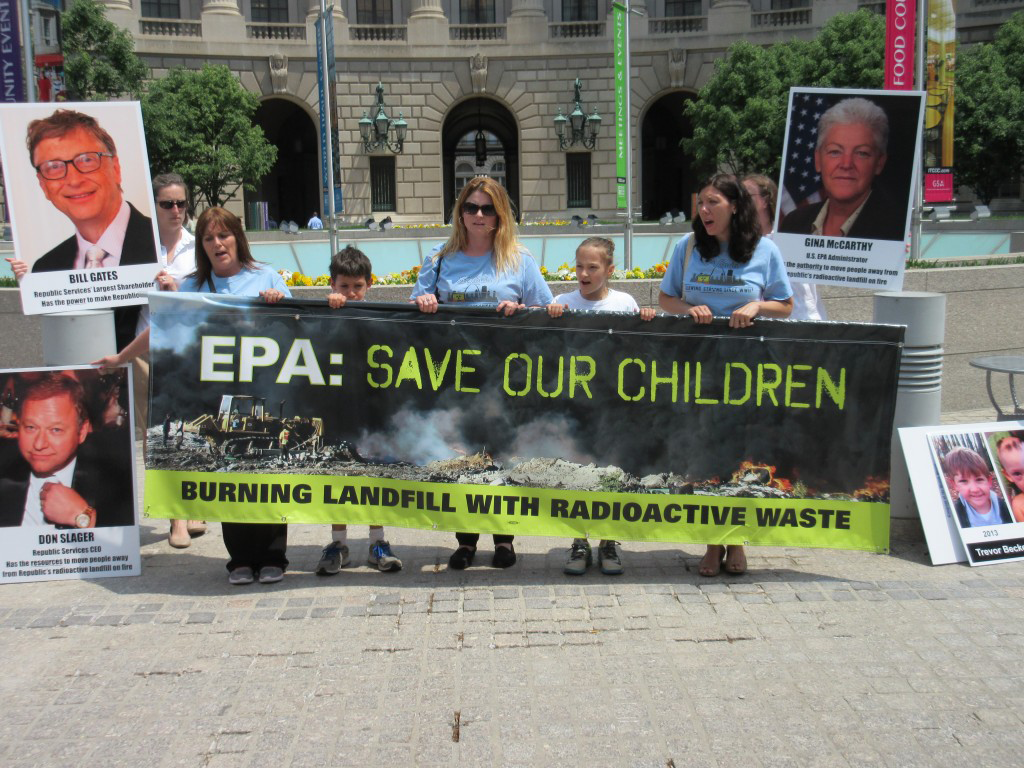
Residents march to put pressure on the EPA and the company who owns the site, of which Bill Gates is a shareholder, to evacuate the residents. (Photo: Center for Health, Environment, and Justice)
CURWOOD: Lois, before you leave, what do you hope happens with this situation? What are your aspirations for these people?
GIBBS: What I'm hoping will happen is that EPA would agree to evacuate all those who wish to leave within that two mile radius and would agree to dig up that high-level radioactive waste and put it in a safe place not in the middle of the community and do something about the fire. They can't put it out but there must be another way to stop the air pollution that is coming from it. But it's very frustrating because this is worse than Love Canal, it's worse than any site I've been and its because it's radioactive waste, it's a garbage landfill, it's a fire and that's just terrifying - it's absolutely terrifying and I just, my heart goes out to these folks and I spend more time on this site than any other ones because of the situation.
CURWOOD: Lois Gibbs is Executive Director of the Center for Health, Environment and Justice. Thanks so much for taking the time today.
GIBBS: Thanks for having me.
CURWOOD: We contacted the EPA and Republic Services for comment. A spokesman for Republic Services told us there are no health risks to the community from the two sites, the company does not believe the radioactive waste will catch fire and the EPA is in charge. The EPA statement reads in part:
“The conditions at the site currently do not present the kind of threat to human health that would require relocation of nearby residents. This agency will continue working toward a final remedy to ensure that the site remains that way.”
The full statements and more information are on our website LOE.org.
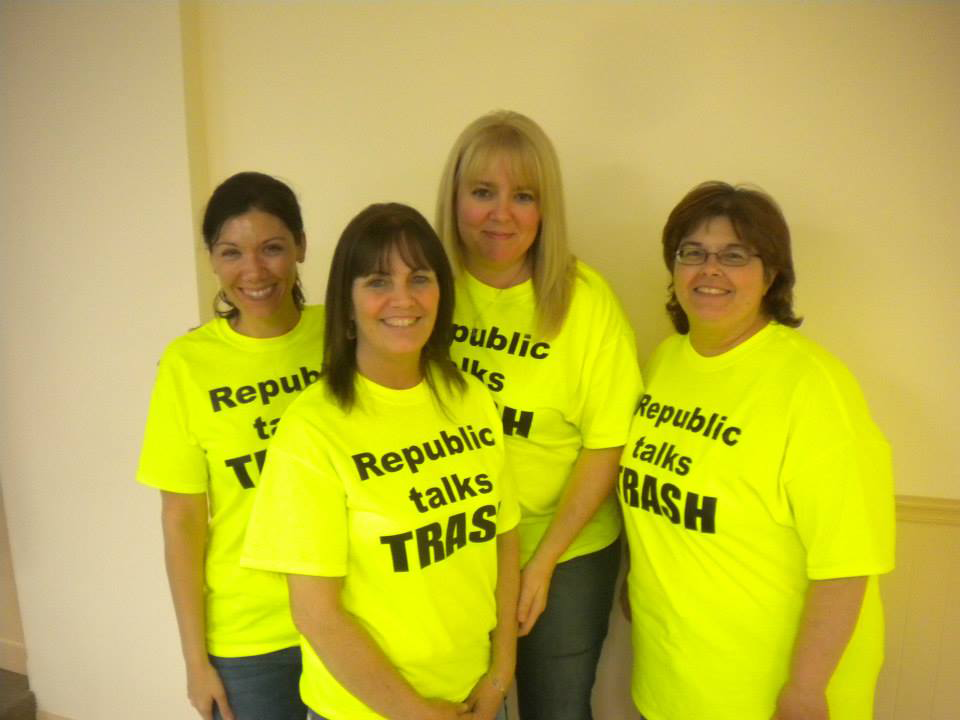
Just Moms St. Louis is a non-profit activism group against the radioactive Superfund site left over from the Manhattan Project in their Community. (Photo: Center for Health, Environment and Justice)
Comments from Republic Services, the owner of the West Lake site:
1. What are the health risks from the contamination at West Lake to people in the surrounding community?
None. And, that is after 30-plus years with no remedy. Please check with the EPA. They have been consistent on this for years.
2. What if anything is Republic Services doing to mitigate those risks or evacuate vulnerable residents?
The site, along with the adjacent Bridgeton Landfill, is arguably one of the most closely monitored sites in the country. The EPA has authority over West Lake. At Bridgeton, which is a site we also acquired in 2008 as part of a much larger transaction, the Landfill has invested in highly sophisticated systems and operations to control odor and manage a subsurface reaction. It is among the most advanced civil engineering projects recently completed in the State, and the work was paid for by the Landfill.
3. How concerned is Republic about the fire at the Bridgeton site, and what are they doing to prevent the fire from reaching the West Lake contamination?
We do not believe it will happen. The subsurface reaction continues to be isolated to one portion of the South Quarry. It would have to reverse direction, defy a few laws of physics by climbing up and moving several hundred feet in the opposite direction, then pass through an area of soil where there is no trash (fuel for the reaction), and still keep going before it reached the radiologically impacted materials in the adjacent West Lake Landfill. The EPA has been clear that, at most, this would result in a release of radon, which safely, quickly and naturally dissipates in air.
4. Who does Republic Services feel should be responsible for the contamination?
I would characterize it as drive-by reporting. Al Jazeera ignored wider concerns associated with the notion of excavation and transportation held by community leaders in St. Louis and citizens throughout the central and western portions of the State.
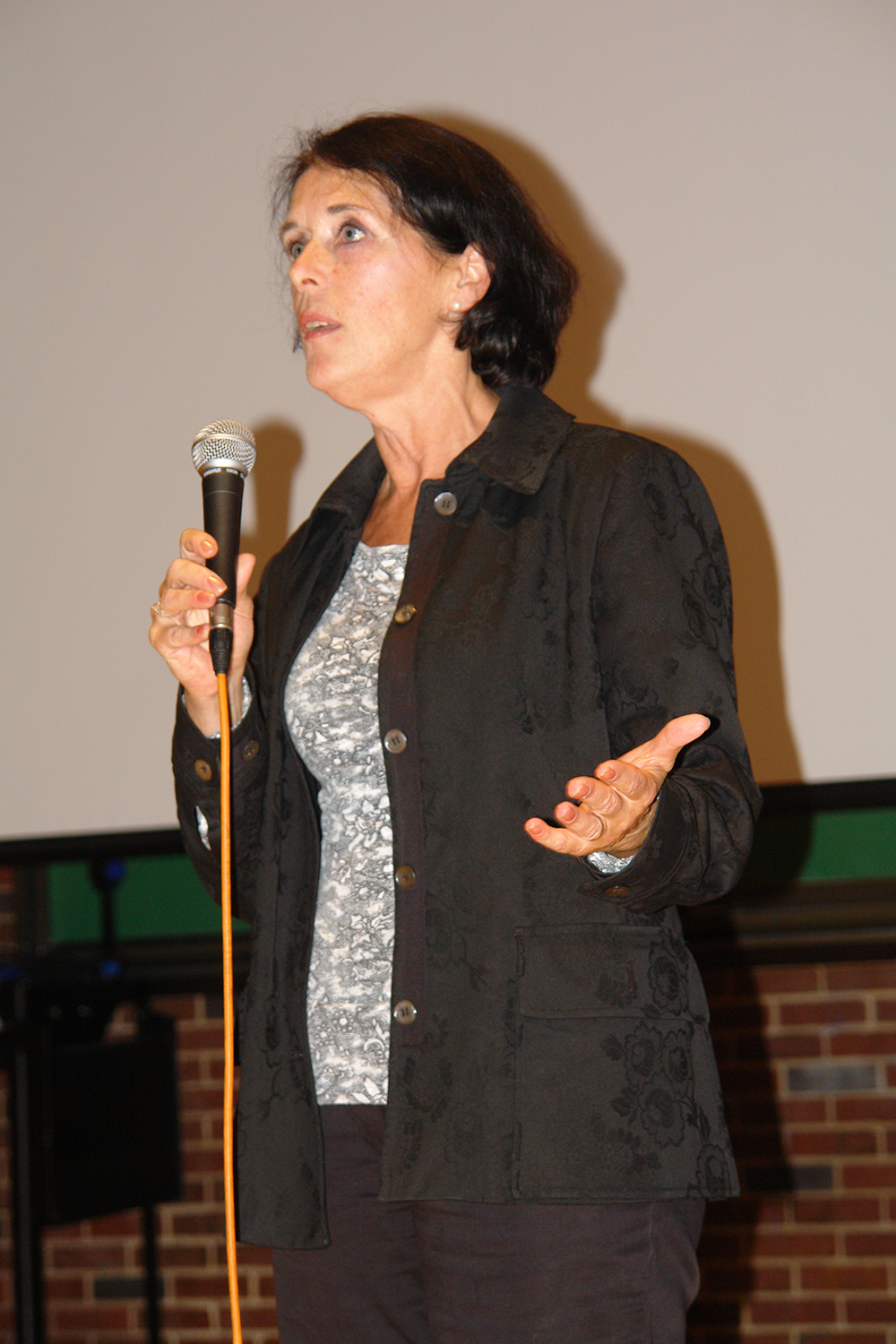
Activist Lois Gibbs (Photo: yoopernewsman, Wikimedia CC BY 3.0)
Full Statement from EPA:
EPA Region 7 is committed to ensuring the public is protected from the radioactive contaminants at the West Lake Landfill Superfund Site. EPA bases its decisions on valid, scientific data, which this agency shares with the community. Based on the body of evidence available EPA Region 7 has concluded that the conditions at the site currently do not present the kind of threat to human health that would require relocation of nearby residents. This agency will continue working toward a final remedy to ensure that the site remains that way.
EPA Region 7 is leading a comprehensive multi-agency effort, including the U.S. Corps of Engineers, and the U.S. Geological Survey, to establish a final remedy for the site. EPA is also supporting the Missouri Department of Natural Resources’ and Missouri Attorney General’s work to protect public health from the subsurface smoldering event in the adjacent Bridgeton Landfill.
Links
Read more about the situation at the West Lake landfill in Al Jazeera
Living on Earth wants to hear from you!
Living on Earth
62 Calef Highway, Suite 212
Lee, NH 03861
Telephone: 617-287-4121
E-mail: comments@loe.org
Newsletter [Click here]
Donate to Living on Earth!
Living on Earth is an independent media program and relies entirely on contributions from listeners and institutions supporting public service. Please donate now to preserve an independent environmental voice.
NewsletterLiving on Earth offers a weekly delivery of the show's rundown to your mailbox. Sign up for our newsletter today!
 Sailors For The Sea: Be the change you want to sea.
Sailors For The Sea: Be the change you want to sea.
 The Grantham Foundation for the Protection of the Environment: Committed to protecting and improving the health of the global environment.
The Grantham Foundation for the Protection of the Environment: Committed to protecting and improving the health of the global environment.
 Contribute to Living on Earth and receive, as our gift to you, an archival print of one of Mark Seth Lender's extraordinary wildlife photographs. Follow the link to see Mark's current collection of photographs.
Contribute to Living on Earth and receive, as our gift to you, an archival print of one of Mark Seth Lender's extraordinary wildlife photographs. Follow the link to see Mark's current collection of photographs.
 Buy a signed copy of Mark Seth Lender's book Smeagull the Seagull & support Living on Earth
Buy a signed copy of Mark Seth Lender's book Smeagull the Seagull & support Living on Earth

